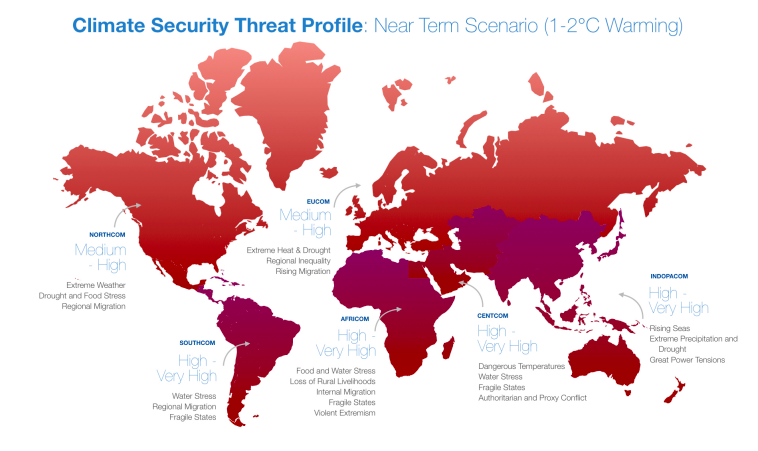The climate emergency is already showing its first effects in many parts of the world, from food shortages to sea-level rise. But another, less considered threat, comes from security.
If the trend continues, there will be even deeper changes that could threaten global security in the coming decades, according to a new report by the National Security, Military and Intelligence Panel (NSMIP).
“If global emissions are not reigned in, the world will experience destabilizing changes in both the near and medium-to-long terms which pose significant threats to security environments, infrastructure, and institutions,” the report reads.

The Center for Climate and Security, a nonpartisan security policy institute that groups security, military, and intelligence experts, concluded there are high-to-catastrophic threats to security from climate change, which could only be avoided by reducing fast and strong the level of emissions.
“Even at scenarios of low warming, each region of the world will face severe risks to national and global security in the next three decades. Higher levels of warming will pose catastrophic, and likely irreversible, global security risks over the course of the 21st century,” the experts wrote.
The world would face “high” to “very high” security threats in the near-term with global warming between one and two degrees Celsius, according to the report. But if the world warms from two to four degrees Celsius the threats would be “very high” or even “catastrophic.”
Under the first scenario, North America would experience more extreme weather events, with significant impacts on life and property. With higher warming, infrastructure would suffer critical impacts and increase divisions in society, the report argued.
In Europe, under the first scenario, there would be severe weather events that would destabilize key economic sectors, rise inequalities and impact on infrastructures. If the temperature goes higher, there would be significant internal displacement.
At low levels of warming, the areas hit the hardest are those that are already the most vulnerable: dry and arid regions, least-developed countries, small island states, and the Arctic polar region, the report also adds.

The experts also concluded that in all the levels of global warming analyzed at the report the world would face “significant and evolving” threats to global security environments, infrastructure, and institutions. The most fragile parts of the world would be the most affected, especially at a low warming threshold.
“The assessment is clear – climate change is a pressing risk to national and global security and will evolve to become a severe and systemic threat the more we allow global temperatures to rise. No region of the world will be left unaffected,” said Sherri Goodman, senior strategist at the Center for Climate and Security.
In order to mitigate those risks, the experts said a steep reduction and phase-out of global greenhouse gas emissions is needed. They called for net-zero global emissions across the globe as soon as possible so to avoid the severe and catastrophic security futures described in the report.
At the same time, they highlighted the importance of resilience to the current and expected impacts of climate change. That would mean developing “climate-proof” environments, infrastructure and institutions and systems on which human security depends.
“Though we are facing unprecedented risks from climate change, as the report shows, we also possess unprecedented foresight about those risks. This underscores a responsibility to prepare for and prevent the security consequences of a changing climate,” said Francisco Femia and Caitlin Werrel, co-founders of the Center for Climate and Security.
Global warming has already exceeded 1ºC compared to pre-industrial levels and could reach up to 4ºC if the world continues on the same path. The Paris Agreement on climate change asked countries to limit the temperature increase to 2ºC but ambition hasn’t been as high as needed so far.


